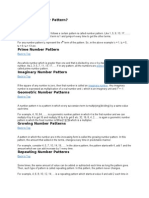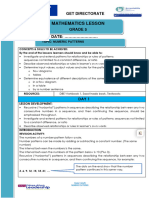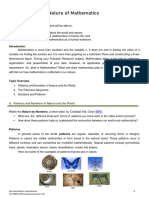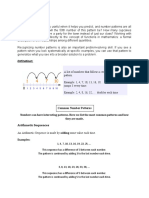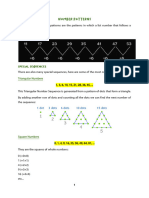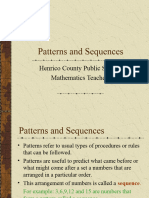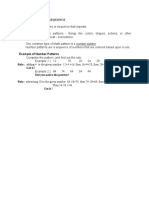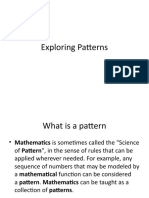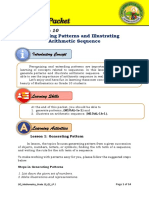Number Patterns and Sequences
1. Definition:
• Number Pattern: A sequence of numbers that follow a specific rule or formula.
• Sequence: An ordered list of numbers that often follows a specific pattern.
2. Types of Sequences:
• Arithmetic Sequence: A sequence where each term is obtained by adding a fixed number (the
common difference) to the previous term.
Example: 2, 5, 8, 11 (common difference = 3)
• Geometric Sequence: A sequence where each term is obtained by multiplying the previous term
by a fixed number (the common ratio).
Example: 3, 6, 12, 24 (common ratio = 2)
• Fibonacci Sequence: A special sequence where each term is the sum of the two preceding ones,
starting from 0 and 1.
Example: 0, 1, 1, 2, 3, 5, 8, 13...
3. Finding Patterns:
• To identify the rule in a number pattern, look for similarities in how the numbers change. Ask:
o Is there a constant amount being added or subtracted?
o Are numbers being multiplied or divided?
4. Using Patterns to Solve Problems:
• Patterns can be used to predict future numbers in a sequence.
• For example, if you know the first five terms of an arithmetic sequence, you can find the 10th
term using the general formula:
Tn=a+(n−1) ×d
where Tn is the nth term, a is the first term, d is the common difference, and n is the term number.
5. Practical Activities:
• Extend number patterns by continuing sequences.
• Create your own number patterns and challenge classmates to find the rule.
• Use everyday situations, like counting objects or money, to find and create patterns.


